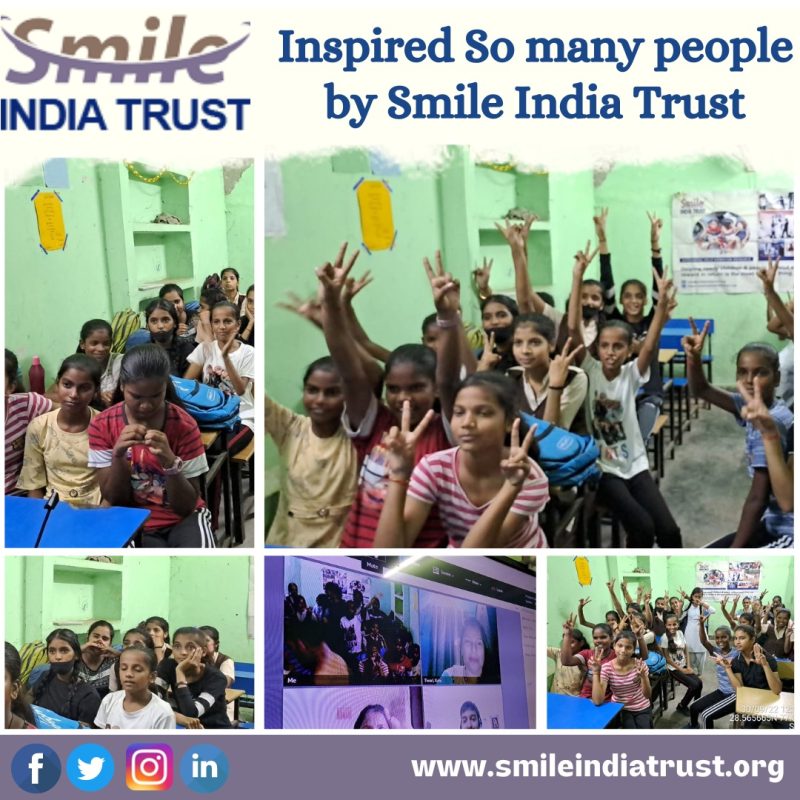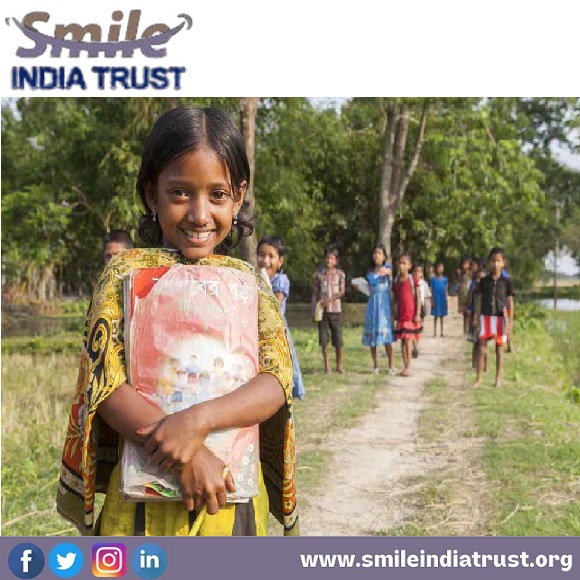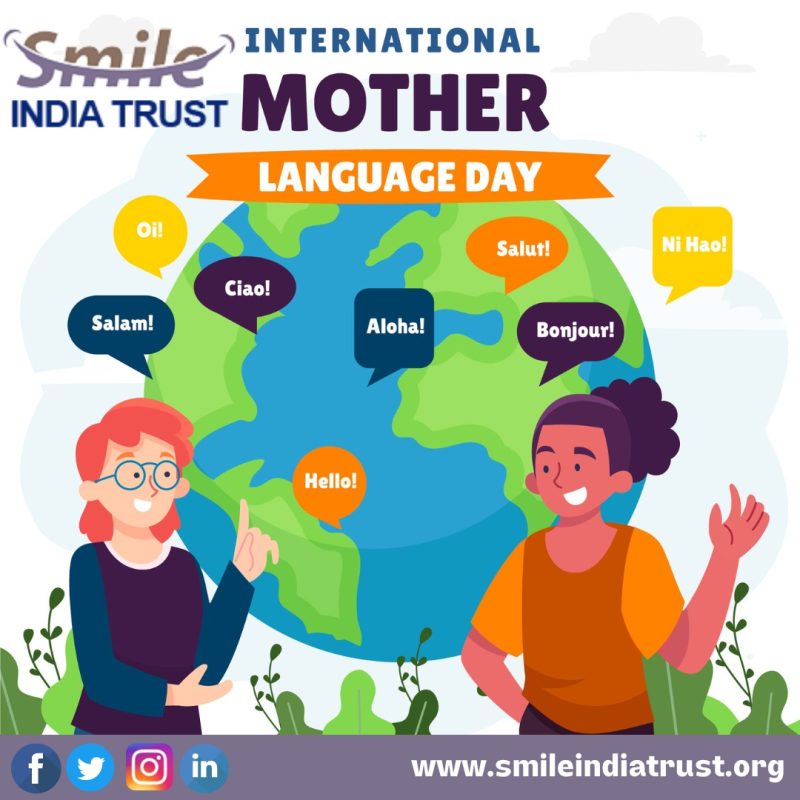,“If you talk to a man in a language he understands, that goes to his head. If you talk to him in his language, which goes to his heart.”- Nelson Mandela
A “mother tongue” is the language, which a person learns from parturition. It is usually that person’s native language, of the kind that he understands from his parents and family. Smile Trust Indi in today’s article will share information about International Mother Language Day.
It is through one such language that a child initially gets to know how to socially interact with other people. Language is the most crucial element in communicating with anyone. A mother tongue was spoken and known by all the people of our country. Through our national language, people of all religions can come together and develop our country by walking together. All the people of our country are becoming aware of the Hindi language. Today, we can easily understand the language of the place where we were born.
If we can speak even more, than our mother tongue, we can take information about other languages and explain it to those people who do not have knowledge of that language, that’s why the United Nations talked about celebrating Mother Language Day.
The people should have knowledge of every language. Although many languages are spoken in our country, Hindi has been designated as the national language, and we should try to learn other languages in addition to Hindi.
Along with Hindi, we should also learn English so that we can give knowledge to people in all languages. Smile Trust Indi honours International Mother Language Day by guiding and informing children about the value of their mother tongue.
Smile Trust Indi on the Importance of Mother Language
Language Children in their early years understand things faster than anyone else, from grasping the word to expression. The mother tongue is the way of communication with which a person is most familiar.
Language creation is to meet humans’ socioeconomic desire for more effective communication. Language, a highly complicated and flexible system, is used to communicate our experiences and thoughts to others. As a result, language is a naturally occurring phenomenon that learners understand at an early age in order to interact with others.
The mother tongue, or native, language, is indeed an important part of one’s family background because it shapes how one sees the world and conveys one to others. Children often mimic what they perceive or hear. Infants are extremely intelligent because they learn one‘s mother tongue mimicking their parents. In contrast to grownups learning a new language, children learn languages more easily during their growing years.
The ability to learn in one’s native language is an extremely powerful tool. Children learn to communicate by having a conversation with one‘s family members in their native language. In addition, in an education or institutional setting, this good communication is critical for participation in the classroom. Learning in school is important in emphasizing how to use the mother language.
Every language has a distinct flavour that reflects the nation and individuals who speak it. In spite of the fact that all languages can be used to communicate, each one has a unique style that is impossible to translate completely.
History of International Mother Language Day
The history behind this precious day is significant that East Pakistan and West Pakistan, two independent Muslim states, and a separate state created when India attained independence from British domination. There was a cultural and linguistic divide dividing Pakistan and Bangladesh, formerly known as West Pakistan and East Pakistan respectively.
Tensions increased after the Pakistani government proclaimed Urdu to be the country’s official tongue in 1948. The predominantly Bengali-speaking population of East Pakistan violently protested the government’s choice multiple times. On February 21, 1952, a few University of Dhaka students and several activists organized a demonstration.
Following that day, four university students kill when the cops opened fire on the crowd of students and protesters. On International Mother Language Day, we remember the martyrdom of these kids who struggled for the recognition of Bengali as their mother tongue.
Bengal Language
Bengali was officially considered the second official language of Pakistan on February 29, 1956. Bengali as the official language of East Pakistan in 1971, which later formed Bangladesh.
After that in 1991 during General Conference of UNESCO, declared International Mother Language Day that welcomed by 188 countries and opposition only by Pakistan. General Assembly of UNESCO on 2002 proclaimed this to celebrate every year on 21st February. The main reason to celebrate the day with more importance now is due to the extension of more than 250 languages in India.
When we talk about languages in India, there are more than 19,500 spoken languages, according to the 2011 census. People speak more than 121 languages; however, only 22 stated in the 8th Schedule of the Indian Constitution.
As India has no national language, Hindi and English designated as official languages. The following language includes in the Constitution, Hindi, Dogri, Kannada, Nepali, Sainthali, Konkan, Urdu, Kannada, Tamil, Telugu, Marathi, Assamese, Bengali, Malayalam, Odiya, Sanskriti, Sindhi Bodo, Maithali, Kashmiri, and Manipuri.
Current Status of Languages in India
If see the figures of UNESCO there are 3000 endangered languages who will disappear till end of century. This is an alarming situation for the world. We will talk about the atlas of UNESCO Atlas of the five main categories.
- Vulnerable Languages- These are the languages prohibited to certain areas but talk by many people.
- Definitely Endangered- Where children are unknown of the mother tongue in the home.
- Severely Endangered – The language understood by parents and not used to talk with children while speaking with grandparents.
- Critically Endangered – The language by grandparents and the younger generation infrequently.
- Extinct- The language which extinct in 1950s and there is no speaker.
The objective of International Mother Language Day
Even when people speak in their native language. This is the main reason why people are not keen to talk in their native language. When we talk about educating people, they are not provided with their native language, as many people are more comfortable in their mother tongue.
Providing education in the mother tongue is the best way to uplift people and protect the native language from extension. Other than Hindi, which has 44% of the count of languages spoken, there are 120 languages native people speak, which is a large number.
This day observes every year to promote linguistic and cultural diversity and multilingualism.
The theme for International Mother Language Day
Smile Trust Indi sees that there is no doubt that International Mother Language Day. Basically, Without question, this campaign increased awareness of language-related issues and mobilized partners and resources to encourage the implementation of multilingualism and language diversity policies and strategies in many countries around the world.
Smile Trust Indicannot denies the importance of language in all types of communication or the crucial role it plays in the development and evolution of human society. Let us tell you that linguistic diversity becoming more and more endangered, which is why the International Year of Languages started
2023- Yet to decided
2022- Using technology for multilingual learning: Challenges and opportunities.
2021-Fostering multilingualism for inclusion in education and society.
2020- Languages without borders.
2019-Indigenous languages matter for development, peace building, and reconciliation
2018-Our languages, our assets.
2017- Towards Sustainable Futures through Multilingual Education.
2016- Quality education, language(s) of instruction and learning outcomes
2015-Inclusive Education through and with language- Language Matters.
2014- Local Languages for Global Citizenship: Spotlight on Science
2013- Books for Mother Tongue Education
Conclusion
However, Smile Trust Indi will eventually come to the conclusion that the mother language is an important part of one’s life. They need to understand that first, we should learn our mother tongue, with which we are most comfortable.
For any kind of guidance or support, you can write us at [email protected]. Visit our website to understand our work in detail. Click on https://smileindiatrust.org/ to know more about us. Follow us on various social media platforms. We are available on Facebook, Instagram, Twitter




